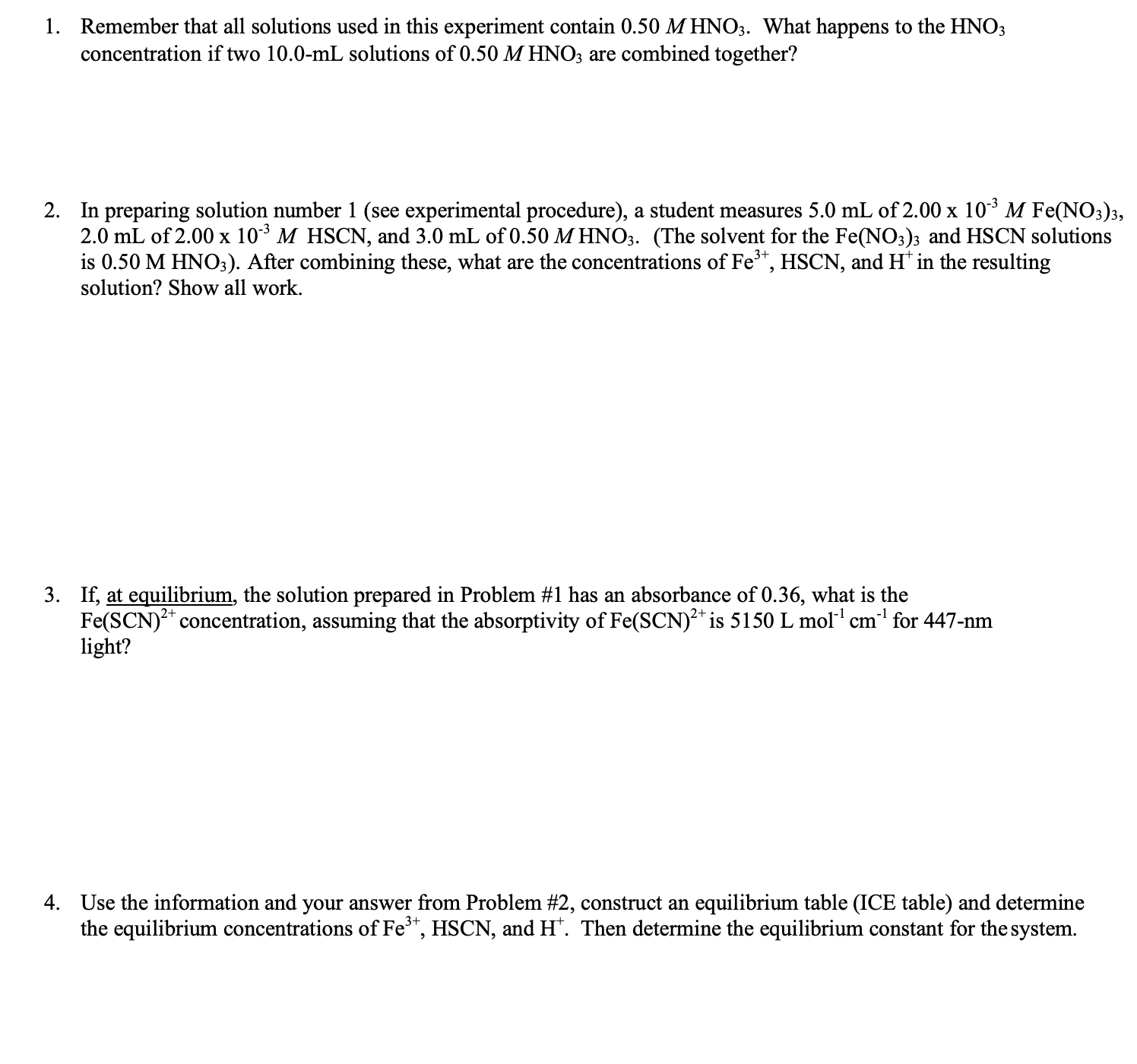1. Remember that all solutions used in this experiment contain 0.50 M HNO;. What happens to the HNO3 concentration if two 10.0-mL solutions of 0.50 M HNO; are combined together? In preparing solution number 1 (see experimental procedure), a student measures 5.0 mL of 2.00 x 10* M Fe(NO3)3, 2.0 mL of 2.00 x 10* M HSCN, and 3.0 mL of 0.50 M HNO3. (The solvent for the Fe(NO3)3 and HSCN solutions is 0.50 M HNO;). After combining these, what are the concentrations of Fe", HSCN, and H* in the resulting solution? Show all work. 2. 3. If, at equilibrium, the solution prepared in Problem #1 has an absorbance of 0.36, what is the Fe(SCN)** concentration, assuming that the absorptivity of Fe(SCN)?* is 5150 L mol' cm' for 447-nm light? 4. Use the information and your answer from Problem #2, construct an equilibrium table (ICE table) and determine the equilibrium concentrations of Fe", HSCN, and H*. Then determine the equilibrium constant for the system.
1. Remember that all solutions used in this experiment contain 0.50 M HNO;. What happens to the HNO3 concentration if two 10.0-mL solutions of 0.50 M HNO; are combined together? In preparing solution number 1 (see experimental procedure), a student measures 5.0 mL of 2.00 x 10* M Fe(NO3)3, 2.0 mL of 2.00 x 10* M HSCN, and 3.0 mL of 0.50 M HNO3. (The solvent for the Fe(NO3)3 and HSCN solutions is 0.50 M HNO;). After combining these, what are the concentrations of Fe", HSCN, and H* in the resulting solution? Show all work. 2. 3. If, at equilibrium, the solution prepared in Problem #1 has an absorbance of 0.36, what is the Fe(SCN)** concentration, assuming that the absorptivity of Fe(SCN)?* is 5150 L mol' cm' for 447-nm light? 4. Use the information and your answer from Problem #2, construct an equilibrium table (ICE table) and determine the equilibrium concentrations of Fe", HSCN, and H*. Then determine the equilibrium constant for the system.
Principles of Modern Chemistry
8th Edition
ISBN:9781305079113
Author:David W. Oxtoby, H. Pat Gillis, Laurie J. Butler
Publisher:David W. Oxtoby, H. Pat Gillis, Laurie J. Butler
Chapter11: Solutions
Section: Chapter Questions
Problem 40P
Related questions
Question

Transcribed Image Text:1. Remember that all solutions used in this experiment contain 0.50 M HNO;. What happens to the HNO3
concentration if two 10.0-mL solutions of 0.50 M HNO; are combined together?
In preparing solution number 1 (see experimental procedure), a student measures 5.0 mL of 2.00 x 10* M Fe(NO3)3,
2.0 mL of 2.00 x 10* M HSCN, and 3.0 mL of 0.50 M HNO3. (The solvent for the Fe(NO3)3 and HSCN solutions
is 0.50 M HNO;). After combining these, what are the concentrations of Fe", HSCN, and H* in the resulting
solution? Show all work.
2.
3. If, at equilibrium, the solution prepared in Problem #1 has an absorbance of 0.36, what is the
Fe(SCN)** concentration, assuming that the absorptivity of Fe(SCN)?* is 5150 L mol' cm' for 447-nm
light?
4. Use the information and your answer from Problem #2, construct an equilibrium table (ICE table) and determine
the equilibrium concentrations of Fe", HSCN, and H*. Then determine the equilibrium constant for the system.
Expert Solution
This question has been solved!
Explore an expertly crafted, step-by-step solution for a thorough understanding of key concepts.
This is a popular solution!
Trending now
This is a popular solution!
Step by step
Solved in 5 steps with 3 images

Recommended textbooks for you

Principles of Modern Chemistry
Chemistry
ISBN:
9781305079113
Author:
David W. Oxtoby, H. Pat Gillis, Laurie J. Butler
Publisher:
Cengage Learning

Chemistry: Principles and Reactions
Chemistry
ISBN:
9781305079373
Author:
William L. Masterton, Cecile N. Hurley
Publisher:
Cengage Learning


Principles of Modern Chemistry
Chemistry
ISBN:
9781305079113
Author:
David W. Oxtoby, H. Pat Gillis, Laurie J. Butler
Publisher:
Cengage Learning

Chemistry: Principles and Reactions
Chemistry
ISBN:
9781305079373
Author:
William L. Masterton, Cecile N. Hurley
Publisher:
Cengage Learning


Chemistry
Chemistry
ISBN:
9781305957404
Author:
Steven S. Zumdahl, Susan A. Zumdahl, Donald J. DeCoste
Publisher:
Cengage Learning

Chemistry: An Atoms First Approach
Chemistry
ISBN:
9781305079243
Author:
Steven S. Zumdahl, Susan A. Zumdahl
Publisher:
Cengage Learning

Chemistry by OpenStax (2015-05-04)
Chemistry
ISBN:
9781938168390
Author:
Klaus Theopold, Richard H Langley, Paul Flowers, William R. Robinson, Mark Blaser
Publisher:
OpenStax